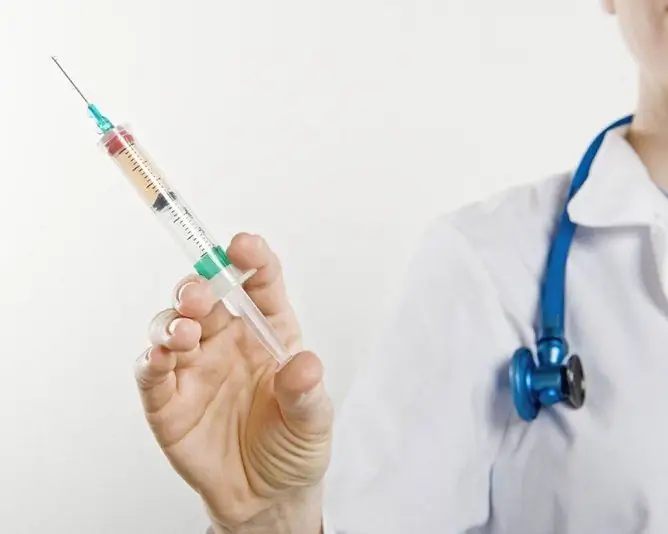- Author Rachel Wainwright [email protected].
- Public 2023-12-15 07:39.
- Last modified 2025-11-02 20:14.
Meriofert
Meriofert: instructions for use and reviews
- 1. Release form and composition
- 2. Pharmacological properties
- 3. Indications for use
- 4. Contraindications
- 5. Method of application and dosage
- 6. Side effects
- 7. Overdose
- 8. Special instructions
- 9. Application during pregnancy and lactation
- 10. Use in childhood
- 11. Drug interactions
- 12. Analogs
- 13. Terms and conditions of storage
- 14. Terms of dispensing from pharmacies
- 15. Reviews
- 16. Price in pharmacies
Latin name: Meriofert
ATX code: G03GA02
Active ingredient: menotropins (Menotropins)
Manufacturer: IBSA Institute Biokimik S. A. (IBSA Institut Biochimique, SA) (Switzerland)
Description and photo update: 2019-08-10

Meriofert is a follicle-stimulating drug.
Release form and composition
The drug is produced in the form of a lyophilisate for the preparation of a solution for subcutaneous and intramuscular administration, which is a compacted mass from white to light yellow [75 IU FSH (International Units of Follicle Stimulating Hormone) + 75 IU LH (International Units of Luteinizing Hormone) or 150 IU FSH + 150 IU LH in clear glass vials; in a cardboard box 1 bottle with lyophilisate complete with 1 ampoule of solvent or 10 individual cardboard boxes with lyophilisate and solvent in a common cardboard box and instructions for use of Meriofert].
The solvent is a colorless, odorless, transparent liquid.
Composition for 1 bottle with lyophilisate:
- active substance: menotropin - highly purified human menopausal gonadotropin (hMG) - 75 IU FSH + 75 IU LH or 150 IU FSH + 150 IU LH;
- auxiliary components: lactose monohydrate.
Composition for 1 ampoule with solvent:
- sodium chloride (pyrogen-free for injection) - 9 mg;
- water for injection - up to 1 ml.
Pharmacological properties
Pharmacodynamics
Meriofert is a highly purified menopausal human gonadotropin from the group of menotropins. The ratio of the biological activity of luteinizing and follicle-stimulating hormones in the preparation is 1 ÷ 1. Menotropin is obtained from postmenopausal female urine.
Receptors for gonadotropins are found exclusively in the tissues of the male and female genital organs. FSH binds to receptors located in the testes on the surface of Sertoli cells and in the ovaries on the surface of the granulosa cells of small follicles. LH binds to granulosa cells of large follicles and to receptors that are located on the surface of the corpus luteum and theca cells in the ovaries.
In women, Meriofert is used to stimulate the growth and maturation of ovarian follicles, endometrial proliferation and increase the concentration of estrogen; in men - in order to stimulate spermatogenesis in oligoasthenospermia and azoospermia.
Pharmacokinetics
The biological effectiveness of the drug is mainly due to the follicle-stimulating component. The pharmacokinetics of Meriofert with subcutaneous and intramuscular administration varies significantly in each case.
After a single intramuscular and subcutaneous injection of 300 IU of the drug, the maximum plasma concentration was reached after 19 hours and 22 hours, respectively. The bioavailability of hMG when administered subcutaneously was higher than when administered intramuscularly.
Most of the drug is excreted by the kidneys. After a single injection of 300 IU Meriofert (according to FSH), the half-life is 40 hours and 45 hours (for subcutaneous and intramuscular administration, respectively).
Indications for use
The use of Meriofert in women is indicated in the following cases:
- anovulation (including with PCOS - polycystic ovary syndrome, if treatment with clomiphene is ineffective);
- controlled ovarian hyperstimulation during ART (assisted reproductive technologies) (as a means of inducing the growth of multiple follicles).
In men, Meriofert is used to stimulate spermatogenesis in oligoasthenospermia and azoospermia, which are caused by acquired or congenital hypogonadotropic hypogonadism (in combination therapy with preparations of human chorionic gonadotropin).
Contraindications
General contraindications for women and men:
- insufficiency of the adrenal cortex (hypocorticism);
- decompensated thyroid disease;
- tumors of the hypothalamus or pituitary gland;
- hyperprolactinemia (increased serum prolactin levels);
- children and adolescents up to 18 years old;
- hypersensitivity to the main or auxiliary components of the drug.
Additional contraindications for the administration of Meriofert's injections to women:
- bleeding from the vagina of unknown origin;
- genital anomalies that are incompatible with pregnancy;
- primary ovarian failure;
- uterine fibroids incompatible with pregnancy;
- ovarian cysts or persistent ovarian enlargement (not associated with PCOS);
- estrogen-dependent cancers (uterine cancer, ovarian cancer, breast cancer);
- the period of pregnancy and lactation.
Additional contraindications for the use of Meriofert for men:
- primary testicular failure;
- androgen-dependent tumors (testicular tumor, prostate cancer, breast cancer).
Meriofert is prescribed with caution in the presence of the following risk factors for thromboembolic complications:
- thrombophilia;
- severe obesity (with a body mass index of more than 30 kg / m 2);
- family or individual predisposition to thromboembolism and / or thrombosis.
Meriofert, instructions for use: method and dosage
Meriofert's injections are administered subcutaneously (subcutaneously) or intramuscularly (intramuscularly), periodically changing the injection site. Subcutaneous administration is preferable, since this method of administration ensures the greatest absorption of the active substance. Treatment with the drug should be carried out under the supervision of a physician with relevant experience and specialization.
The solution is prepared just before injection. Use the supplied diluent to dilute the lyophilisate. Doses of the drugs that are described below are given by the amount of FSH. They are the same for both subcutaneous and intramuscular administration.
For women, the dose of Meriofert is selected individually, taking into account the reaction of the ovaries. The ovarian response to treatment is assessed by ultrasound (ultrasound) and the determination of the plasma concentration of estradiol.
Anovulation (including PCOS if treatment with clomiphene is ineffective)
The drug can be administered daily. The use of Meriofert must be started in the first 7 days of the cycle. The initial dose is 75-150 IU per day. If the ovarian response is insufficient, the dose is gradually increased. The interval for increasing the dose is at least 7 days. It is recommended to increase the daily dose by 37.5 IU (the maximum dose increment is 75 IU). The maximum dose of the drug is 225 IU per day. If within 4 weeks the desired effect is not achieved, injections are stopped, and then therapy is resumed from a new cycle with a higher initial dose. Before the onset of menstrual bleeding, the patient should refrain from sexual intercourse or use barrier contraceptive methods.
After achieving an adequate response of the ovaries to induce ovulation, the patient is injected with hCG (human chorionic gonadotropin) at a dose of 5000-10,000 IU once. HCG preparations are administered the day after the last injection of Meriofert. On the day of hCG administration, as well as the next day, the patient is advised to have sexual intercourse with a partner (an alternative method is intrauterine insemination).
With ovarian hyperstimulation, the administration of Meriofert should be discontinued and the injection of hCG should be abandoned. In the next cycle, treatment is resumed, but the initial dose of the drug should be reduced compared to the initial dose in the previous cycle.
Controlled ovarian hyperstimulation
According to the protocol, 150-225 IU of the drug is injected daily for ovarian hyperstimulation, starting from the 2nd or 3rd day of the cycle. The introduction of Meriofert is continued until a sufficient size of the follicles is reached. Depending on the response to the ongoing therapy, the daily dose is adjusted. The maximum dose is 450 IU FSH per day.
24-48 hours after the last injection, in order to induce the final maturation of the follicles, the patient is injected with 5000-10,000 IU of hCG.
Quite often, GnRH agonists (gonadotropin-releasing hormone agonists) are used to prevent the release of endogenous LH. The use of Meriofert is possible no earlier than 2 weeks after starting therapy with a GnRH-a. In the future, the drugs are used together until an adequate level of follicular development is achieved. The menotropin dose is adjusted according to the ovarian response.
Hypogonadotropic hypogonadism
In men, Meriofert is used to stimulate spermatogenesis in cases where previous treatment with hCG drugs caused only an androgenic reaction, but did not lead to an increase in spermatogenesis. The therapy is continued by administering menotropin at a dose of 75 IU or 150 IU 2-3 times a week in combination with HCG injections (2000 IU 2-3 times a week).
Treatment should be continued for at least 3 months. If there is no positive effect, the course is extended to 18 months.
Side effects
- digestive system: often - nausea, vomiting, abdominal pain, diarrhea, bloating or intestinal colic;
- cardiovascular system: very rarely - thromboembolism;
- nervous system: very often - headache;
- immune system: very rarely - skin rash, skin redness, Quincke's edema;
- genitals and mammary gland: very often - an increase in the ovaries, the formation of cysts in the ovaries; often - breast enlargement (in men), OHSS (ovarian hyperstimulation syndrome); rarely - ovarian torsion;
- skin and subcutaneous fat: often - acne (in men);
- other reactions: very often - redness, irritation, pain, swelling and / or bruising at the injection site.
Overdose
With an overdose of menotropins, thromboembolic complications may occur and OHSS may develop. Signs of OHSS include: nausea, vomiting, shortness of breath, lower abdominal pain, weight gain, ascites, diarrhea, blood accumulation in the abdominal cavity, hydrothorax, oliguria, a decrease in the water content in the blood relative to the number of corpuscles.
With OHSS of mild to moderate severity, additional treatment is not required, the symptoms disappear within 2-3 weeks on their own. With severe OHSS, the patient is admitted to the intensive care unit of a gynecological hospital, where complex treatment is carried out.
special instructions
Before using Meriofert, it is recommended to conduct an examination to identify insufficiency of the adrenal cortex, tumors of the hypothalamus or pituitary gland, hypothyroidism and hyperprolactinemia. If any of the listed diseases is detected, appropriate specific therapy is performed.
OHSS - ovarian hyperstimulation syndrome
OHSS manifestations depend on the severity of this condition. With OHSS, the ovaries significantly increase in size, a high concentration of estrogens is noted in the blood serum, and vascular permeability increases, which sometimes leads to the accumulation of fluid in the pleural, abdominal, and pericardial (rarely, mainly in severe OHSS) cavities. Symptoms of moderate OHSS: nausea, vomiting, bloating, diarrhea, abdominal pain, shortness of breath, weight gain, oliguria, ovarian enlargement. In severe OHSS, ascites, hydrothorax, electrolyte disturbances, acute respiratory distress syndrome are observed, hemoconcentration, hypovolemia develop, thromboembolic complications occur, blood accumulates in the abdominal cavity.
Usually, an overreaction of the ovaries to the administration of menotropin and other gonadotropins is rarely accompanied by OHSS, unless HCG is simultaneously used to stimulate ovulation. That is why, during ovarian hyperstimulation, it is not recommended to inject hCG, and the patient must use barrier methods of contraception or refrain from sexual intercourse for at least 4 days.
OHSS can progress very quickly (from 24 hours to several days), therefore, the patient should be monitored for at least 2 weeks after the HCG injection. If the recommended doses and regimen of Meriofert administration are observed, the likelihood of ovarian hyperstimulation and multiple pregnancy can be minimized. The risk of developing this syndrome during ART can be reduced by aspiration of the contents of all follicles in the ovaries before ovulation occurs.
As pregnancy progresses, OHSS can be prolonged and more severe. Usually the complication occurs after discontinuation of gonadotropin therapy, and reaches a maximum severity 7-10 days after the end of treatment. Most often, the syndrome goes away on its own after the onset of menstrual bleeding. In patients with PCOS, the incidence of OHSS is higher.
Multiple pregnancy
Multiple pregnancies are characterized by an increased risk of adverse perinatal and maternal outcomes. With the use of menotropins, the likelihood of multiple pregnancies is higher than with normal conception. In the case of IVF (in vitro fertilization), the patient should be warned about the possible risk of multiple pregnancy before starting therapy.
Complications of pregnancy and ectopic (ectopic) pregnancy
Spontaneous abortions during pregnancy after menotropin therapy are more common than in healthy women after natural conception.
After IVF, the incidence of ectopic pregnancy is 2-5%. In the general population, ectopic pregnancy is recorded in 1-1.5% of cases.
Genital tumors
There is evidence of cases of benign and malignant tumors of the ovaries and other organs of the reproductive system in women who have undergone infertility treatment with several methods of ART. However, to date, it is not known whether gonadotropin therapy increases the baseline risk of these neoplasms in infertile patients.
Congenital malformations of the fetus
The incidence of congenital malformations of the fetus with IVF and other ART methods is slightly higher than with natural conception. It is believed that the reason for this may be multiple pregnancies and the individual characteristics of the parents (sperm characteristics, mother's age, etc.).
Thromboembolic complications
In women with risk factors for thromboembolic complications during and after gonadotropin therapy, the risk of arterial or venous thrombosis and thromboembolism increases. In these cases, before starting treatment with Meriofert, the ratio of the expected benefit and possible risk should be assessed. It must be remembered that pregnancy itself increases the likelihood of thromboembolic complications.
Meriofert is usually ineffective in men with a high FSH concentration in the blood (elevated FSH levels indicate primary hypogonadism).
Influence on the ability to drive vehicles and complex mechanisms
Meriofert does not affect the patient's psychomotor abilities (ability to concentrate and react quickly).
Application during pregnancy and lactation
Menotropins are contraindicated in pregnant and lactating women.
Pediatric use
The drug should not be administered to children and adolescents under the age of 18 years.
Drug interactions
The simultaneous use of Meriofert with other agents to stimulate ovulation (for example, clomiphene and hCG) can enhance the response of the follicles. Co-administration with a GnRH-a may require an increase in the dose of menotropin.
The prepared solution should not be mixed in the same syringe with other drugs.
Analogs
Meriofert's analogs are Menopausal Gonadotropin, Menopur, Menogon, Menopur Multidose.
Terms and conditions of storage
Store in a dark place, out of the reach of children, at a temperature not exceeding 25 ° C.
Expiration date: solvent - 5 years; lyophilisate - 2 years.
The reconstituted solution must be used immediately after preparation.
Terms of dispensing from pharmacies
Dispensed by prescription.
Reviews about Meriofert
According to reviews, Meriofert does a good job with its main task - stimulating the growth of follicles. The drug does not destroy the endometrium, rarely causes side effects. However, patients note that it can only be used strictly according to the doctor's prescription.
During treatment with Meriofert, some women experienced headaches, heaviness in the calves and a noticeable swelling of the veins in the legs, and slight stretching in the lower abdomen.
Price for Meriofert in pharmacies
The price of Meriofert depends on the dosage:
- lyophilisate for preparation of solution for injections 75 IU FSH + 75 IU LH (1 pc. in a package) - 1150-1400 rubles;
- lyophilisate for the preparation of a solution for injection 150 IU FSH + 150 IU LH (1 piece per package) - 2450 rubles.

Anna Kozlova Medical journalist About the author
Education: Rostov State Medical University, specialty "General Medicine".
Information about the drug is generalized, provided for informational purposes only and does not replace the official instructions. Self-medication is hazardous to health!






